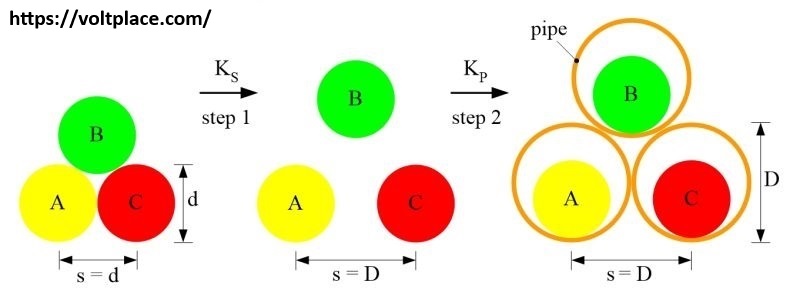
Laying cables in pipes (part 3)

Let’s explain how, using the system of correction coefficients given in cable catalogs, the influence of pipes on the long-term permissible current should be taken into account. The error in such calculations is actually due not only to the fact that the catalogs have lost the relevance of the correction factor Kp = 0.9. To understand, let’s look at the cable line made by three single-core cables laid in the ground. Suppose, instead of laying three phases in the form of a closed triangle, it was decided to place three phases in three separate pipes in a bundle. How will the long-term permissible current of such a cable line change?
In order to properly take into account the effect of laying cables in pipes, we need to discuss not only the direct influence of the pipes themselves (Kp), but also the increase in the distance between phases. Thus, two correction coefficients should be used at once, and the formula for calculating the long-term permissible current of the cable line will have the form: Icc(p) = Ks*Kp*Icc.
In this formula, Icc(p) – is the capacity current when laying cables in pipes in a bundle; Icc – is the current capacity when laying cables in the ground without pipes in the form of a closed triangle, Ks – is a coefficient that takes into account the increase in the distance between phases (STEP 1), Kp – is a coefficient that takes into account the influence of the pipe itself (STEP 2).
STEP 1 (Ks). According to the cable catalog, if the distance between the phases increases, then this can be taken into account by using the correction factor Ks for the distance between the phases. When we change s=d to s=D, it improves cooling conditions and gives Ks>1. The specific values of Ks depend on the values of d and D, but usually range from 1.1 to 1.3.
STEP 2 (Kp). Cable factories, by mistake, believe that the pipe worsens the cooling of the cable and give the value Kp= 0.9 in the catalogs. But real Kp values can reach Kp=1 and there are even cases of Kp>1 (for instance, due to the fact that laying cables in pipes provides a large contact area with the ground and reduces its thermal resistance).
EXAMPLE. Let’s assume Ks=1.2 and Kp=0.9. Then by the formula: Icc(p) = Ks*Kp*Icc = 1.2*0.9*Icc = 1.08*Icc. This means, even in conditions when factories underestimate the Kp value compared to the real one, we still obtained with the help of the catalog that laying cables in pipes increased the permissible current of the cable line by 8% compared to the case of laying without pipes. If we set correct values of Kp >0.9, then the effect of the pipes will be even more noticeable, and the current capacity may increase up to 15% (Ks*Kp=1.15).
Once again, we draw attention to the importance of correctly taking into account the influence of pipes on the current capacity of the cable line. The real situation is that in many cases the laying in the pipes increases the long-term permissible current of the cable line!
